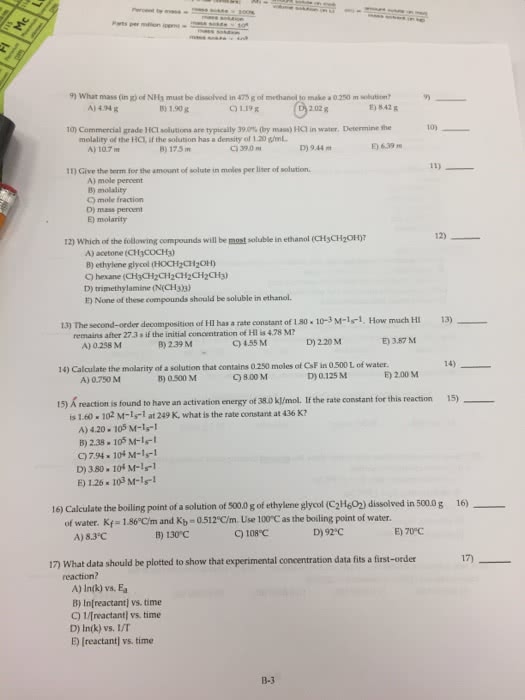CHEM 1A03 Lecture Notes - Lecture 2: Ideal Gas Law, Heat Capacity, Kelvin

35
CHEM 1A03 Full Course Notes
Verified Note
35 documents
Document Summary
U2m2-fundamental skills review: extensive quantities: depend linearly on how much matter you have, ex. Intensive quantifies: remain essentially constant even if amount of matter changes: ex. Temperature scales: celsius scale: 0 is at the freezing point of water; 100 is at the boiling point of water, based on water at sea level, kelvin scale: 0 is the lowest possible temperature in the world. Example: an hcl solution is 28. 0% by mass and has a density of 1. 14g/ml. *assume 100g of solutions (since conc. is an intensive property, we can assume any mass), thus we have 28. 0g of hcl: 0 k = -273. 15 c. Percent by volume: find mols, find volume, d=density g/ml (m, n=moles, v=volume ml (can be l but that would make density g/l, c=concentration mols/l (m, n=moles, v=volume l (cid:1829)=(cid:1866) (cid:1830)=(cid:1865) % (cid:1854)(cid:1877) (cid:1874)(cid:1867)(cid:1864)(cid:1873)(cid:1865)(cid:1857)= (cid:3046)(cid:3042)(cid:3048)(cid:3047) (cid:3046)(cid:3042)(cid:3048)(cid:3047)(cid:3042)(cid:3041)(cid:1876) (cid:883)(cid:882)(cid:882) (cid:1866)= (cid:1865)(cid:1839)(cid:1839) (cid:1866)=(cid:884)(cid:890). (cid:882)(cid:885)(cid:888). (cid:886)(cid:888) (cid:1866)=(cid:882). (cid:889)(cid:888)(cid:889)(cid:891)(cid:887)(cid:1865)(cid:1867)(cid:1864)(cid:1871: vsolution combined total volume, msolution combined total mass.



